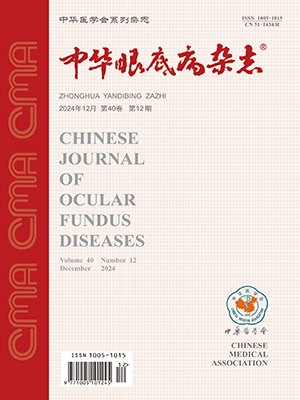| 1. |
王莉菲, 李瑞峰.正确认识理解光学影像检查的原理特点, 提高光学影像检查技术的应用水平[J].中华眼底病杂志, 2011, 27(2):109-113.
|
| 2. |
刘杏.努力提高光相干断层扫描检查结果的认知水平, 提升光相干断层扫描检查的临床应用价值[J].中华眼底病杂志, 2005, 21(2):67-68.
|
| 3. |
黎晓新, 陈玮志.频域光相干断层扫描:眼底影像检查技术的新时代[J].中华眼底病杂志, 2009, 125(3):161-163.
|
| 4. |
许迅.规范眼底影像检查数据采集、评估行为, 提升眼底影像检查诊断技术应用水平[J].中华眼底病杂志, 2013, 29(5):449-452.
|
| 5. |
Palczewska G, Golczak M, Williams DR, et al. Endogenous fluorophores enable two-photon imaging of the primate eye[J]. Invest Ophthalmol Vis Sci, 2014, 55(7):4438-4447.
|
| 6. |
Maeda A, Palczewska G, Golczak M, et al. Two-photon microscopy reveals early rod photoreceptor cell damage in light-exposed mutant mice[J]. Proc Natl Acad Sci USA, 2014, 111(14):1428-1437.
|
| 7. |
Kiss S, Berenberg TL. Ultra widefield fundus imaging for diabetic retinopathy[J]. Curr Diab Rep, 2014, 14(8):514.
|
| 8. |
Wessel MM, Aaker GD, Parlitsis G, et al. Ultra-wide-field angiography improves the detection and classification of diabetic retinopathy[J].Retina, 2012, 32(4):785-791.
|
| 9. |
Wessel MM, Nair N, Aaker GD, et al. Peripheral retinal ischaemia, as evaluated by ultra-widefield fluorescein angiography, is associated with diabetic macular oedema[J]. Br J Ophthalmol, 2012, 96(5):694-698.
|
| 10. |
Patel RD, Messner LV, Teitelbaum B, et al. Characterization of ischemic index using ultra-widefield fluorescein angiography in patients with focal and diffuse recalcitrant diabetic macular edema[J]. Am J Ophthalmol, 2013, 155(6):1038-1044.
|
| 11. |
Tan CS, Heussen F, Sadda SR. Peripheral autofluorescence and clinical findings in neovascular and non-neovascular age-related macular degeneration[J]. Ophthalmology, 2013, 120(6):1271-1277.
|
| 12. |
Witmer MT, Kozbial A, Daniel S, et al. Peripheral autofluorescence findings in age-related macular degeneration[J].Acta Ophthalmol, 2012, 90(6):428-433.
|
| 13. |
Klufas MA, Yannuzzi NA, Pang CE, et al. Feasibility and clinical utility of ultra-widefield indocyanine green angiography[J]. Retina, 2015, 35(3):508-520.
|
| 14. |
Fung TH, Yusuf IH, Xue K, et al. Heidelberg spectralis ultra-widefield fundus fluorescein angiography in infants[J]. Am J Ophthalmol, 2015, 159(1):78-84.
|
| 15. |
Kang KB, Wessel MM, Tong J, et al. Ultra-widefield imaging for the management of pediatric retinal diseases[J].J Pediatr Ophthalmol Strabismus, 2013, 50(5):282-288.
|
| 16. |
郁梅, 张琦, 蔡璇, 等.广角数码视网膜成像系统辅助早产儿视网膜病变激光光凝治疗[J].中华眼底病杂志, 2014, 30(1):90-92.
|
| 17. |
周彦萍, 汪枫桦, 孙晓东, 等.高度近视脉络膜厚度的加强深度成像检查研究进展[J].中华眼底病杂志, 2013, 29(5):539-541.
|
| 18. |
Kim JH, Kang SW, Kim JR, et al. Variability of subfoveal choroidal thickness measurements in patients with age-related macular degeneration and central serous chorioretinopathy[J]. Eye (Lond), 2013, 27(7):809-815.
|
| 19. |
Nishide T, Hayakawa N, Nakanishi M, et al. Reduction in choroidal thickness of macular area in polypoidal choroidal vasculopathy patients after intravitreal ranibizumab therapy[J]. Graefe's Arch Clin Exp Ophthalmol, 2013, 251(10):2415-2420.
|
| 20. |
Jirarattanasopa P, Ooto S, Nakata I, et al. Choroidal thickness, vascular hyperpermeability, and complement factor H in age-related macular degeneration and polypoidal choroidal vasculopathy[J]. Invest Ophthalmol Vis Sci, 2012, 53(7):3663-3672.
|
| 21. |
Ferrara D, Mohler KJ, Waheed N, et al. En face enhanced-depth swept-source optical coherence tomography features of chronic central serous chorioretinopathy[J]. Ophthalmology, 2014, 121(3):719-726.
|
| 22. |
Sayanagi K, Gomi F, Akiba M, et al. En-face high-penetration optical coherence tomography imaging in polypoidal choroidal vasculopathy[J]. Br J Ophthalmol, 2015, 99(1):29-35.
|
| 23. |
Wolff B, Basdekidou C, Vasseur V, et al. "En face" optical coherence tomography imaging in type 2 idiopathic macular telangiectasia [J].Retina, 2014, 34(10):2072-2078.
|
| 24. |
Puche N, Querques G, Blanco-Garavito R, et al. En face enhanced depth imaging optical coherence tomography features in adult onset foveomacular vitelliform dystrophy[J]. Graefe's Arch Clin Exp Ophthalmol, 2014, 252(4):555-562.
|
| 25. |
Jia Y, Tan O, Tokayer J, et al. Split-spectrum amplitude-decorrelation angiography with optical coherence tomography[J].Opt xpress, 2012, 20(4):4710-4725.
|
| 26. |
Jia Y, Wei E, Wang X, et al. Optical coherence tomography angiography of optic disc perfusion in glaucoma[J].Ophthalmology, 2014, 121(7):1322-1332.
|
| 27. |
Jia Y, Bailey ST, Wilson DJ, et al. Quantitative optical coherence tomography angiography of choroidal neovascularization in age-related macular degeneration[J]. Ophthalmology, 2014, 121(7):1435-1444.
|
| 28. |
Spaide RF, Klancnik JM Jr, Cooney MJ. Retinal vascular layers imaged by fluorescein angiography and optical coherence tomography angiography[J]. JAMA Ophthalmol, 2015, 133(1):45-50.
|




